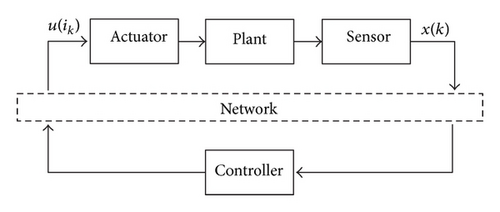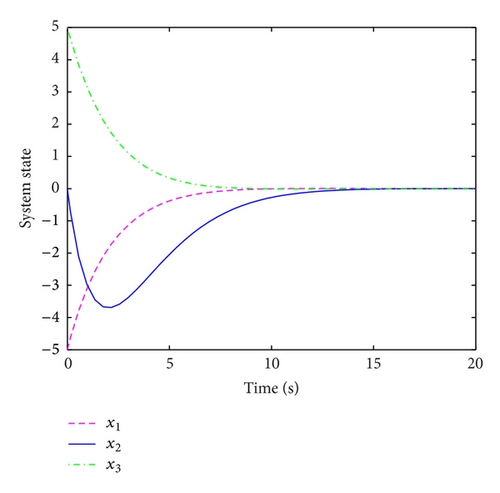Finite-Time Stability and Stabilization of Networked Control Systems with Bounded Markovian Packet Dropout
Abstract
The finite-time stability and stabilization problems of a class of networked control systems (NCSs) with bounded Markovian packet dropout are investigated. The main results provided in the paper are sufficient conditions for finite-time stability and stabilization via state feedback. An iterative approach is proposed to model NCSs with bounded packet dropout as jump linear systems (JLSs). Based on Lyapunov stability theory and JLSs theory, the sufficient conditions for finite-time stability and stabilization of the underlying systems are derived via linear matrix inequalities (LMIs) formulation. Lastly, an illustrative example is given to demonstrate the effectiveness of the proposed results.
1. Introduction
The concept of Lyapunov asymptotic stability is largely known to the control community; see [1] and the references therein. However, often Lyapunov asymptotic stability is not enough for practical applications, because there are some cases where large values of state variables are not acceptable. For this purpose, the concept of finite-time stability (FTS) can be used. Some early results on FTS can be found in [2]; more recently the concept of FTS has been revisited in the light of recent results coming from linear matrix inequalities (LMIs) theory, which has made it possible to find less conservative conditions for guaranteeing FTS and finite time stabilization of discrete-time and continuous-time systems [3, 4]. In [5], finite-time stabilization of linear time-varying systems has been studied. In [6–8], finite-time control problem for the impulsive systems is discussed. In [9], sufficient conditions for finite-time stability and stabilization of a class of nonlinear quadratic systems are also presented. For more analysis and synthesis results of finite control problem, the readers are referred to the literature [10, 11] and the references therein. In [12], sufficient conditions for finite-time boundness and stability of switched system are proposed, and static state and dynamic output feedback controllers are designed to finite-time stabilise switched linear systems. In [13], a new design approach is proposed for robust finite-time H∞ control of a class of Markov jump systems with partially known information. In [14], finite-time reliable guaranteed cost fuzzy control for discrete-time nonlinear systems with actuator faults is investigated. In [15], the finite-time stochastic synchronization problem for complex networks with stochastic noise perturbations is studied. In [16], finite-time synchronization of the singular hybrid coupled networks is investigated.
On the other hand, NCSs are feedback control systems with control loops closed via digital communication channels. Compared with the traditional point-to-point wiring, the use of the communication channels can reduce the costs of cables and power, simplify the installation and maintenance of the whole system, and increase the reliability. Because of these attractive benefits, many industrial companies and institutes have shown interest in applying networks for remote industrial control purposes and factory automation [17]. However, the insertion of communication networks in feedback control loops makes the NCSs analysis and synthesis complex; see [18–20] and the references therein, where much attention has been paid to the delayed data packets of an NCSs due to network transmissions. In fact, data packets through networks suffer not only transmission delays, but also, possibly, packet dropout [21, 22]; the latter is a potential source of instability and poor performance in NCSs because of the critical real-time requirement in control systems.
So far, Lyapunov stability analysis for NCSs with packet dropout has been extensively studied by many researchers [23–25]. However, to date and to the best of our knowledge, the problems of finite-time stabilization of NCSs with Markovian packet dropout have not been fully investigated and still remain challenging, although results related to systems over networks with packet loss are reported in the existing literature, which motivates the study of this paper. The main contributions are given as follows: (1) definitions of finite-time stabilization are extended to NCSs with packet dropout; (2) sufficient conditions for finite-time stabilization in terms of linear matrix inequalities formulation are given.
This paper is organized as follows. An iterative method to model NCSs with bounded Markovian packet dropout as MJLSs is proposed in Section 2. The stochastic stability and stabilization conditions for NCSs are derived via LMIs in Section 3. Section 4 provides numerical examples to illustrate the effectiveness of our results. Finally, Section 5 gives some concluding remarks.
Notations. Throughout this paper, for two matrices A and B, A < B means that A − B is negative definite, and AT denotes the transpose of A. E{·} stands for the mathematical expectation operator. λmax(A) and λmin(A) denote the maximum and minimum eigenvalue of A, respectively. I is the identity matrix.
2. Problem Formulation and Preliminaries

Remark 1. It is worth pointing out that the packet dropout process {r(ik), ik ≥ 0} includes both sensor-to-controller and controller-to-actuator packet dropouts.
The main aim of this paper is to find some sufficient conditions which guarantee that the system given (8) is stable over a finite-time interval. This concept can be formalized through the following definition.
Definition 2. System (8) is said to be finite-time stable with respect to (α, β, R, N), where R is a positive-definite matrix, 0 < α < β, if
To this end, the following lemmas will be essential for the proofs in the next section and theirs proofs can be found in the cited reference.
Lemma 3 (see [26].)For any matrices U ∈ Rn×n and V ∈ Rn×n, if the matrix V > 0, then one has
Lemma 4 (Schur complement lemma; see [26]). For a given symmetric matrix
- (1)
W < 0,
- (2)
W11 < 0, ,
- (3)
W22 < 0, .
3. Main Results
In this section, we will find a state feedback control matrix K, such that system (8) is finite-time stable with respect to (α, β, R, N). In order to solve the problem, the following theorem will be essential.
Theorem 5. For a constant γ > 0, system (8) is finite-time stable with respect to (α, β, R, N) if there exist matrix Pi > 0, i ∈ 𝒮, and two scalars λ1, λ2, such that the following conditions hold:
Proof. Choose the Lyapunov function as
Now we turn back to our original problem, which is to find sufficient conditions which guarantee that the system (8) with the controller (2) is finite-time stable with respect to (α, β, R, N). The solution of this problem is given by the following theorem.
Theorem 6. For a constant γ > 0, system (8) is finite-time stable with respect to (α, β, R, N) if there exist matrix , i ∈ 𝒮, G ∈ ℝn×n, Y ∈ ℝm×n, and two scalars λ1, λ2, such that the following conditions hold:
Proof. By Lemma 4, (27) is equivalent to
Remark 7. For the case of ik < l ≤ ik+1 − 1, the system transient performance can also be accommodated. In fact, denote h(ik) = l − ik ∈ 𝒮. Then we have
4. Numerical Example

5. Conclusions
In this paper, we have considered the finite-time stabilization problems of a class of networked control systems (NCSs) with bounded Markovian packet dropout, based on the iterative approach the NCSs with bounded packet dropout as jump linear systems. The sufficient conditions for finite-time stabilization of the underlying systems are derived via linear matrix inequalities (LMIs) formulation. Lastly, an illustrative example is given to demonstrate the effectiveness of the proposed results.
Conflict of Interests
The authors declare that there is no conflict of interests regarding the publication of this paper.
Acknowledgment
This work was partly supported by the University Natural Science Foundation of Anhui Province no. KJ2013A239 and the University Special Foundation for Young Scientists of Anhui Province no. 2013SQRW052ZD.




